By Badri Narayan
State Assembly elections in Maharashtra and Jharkhand are crucial for both the principal blocs: the Bharatiya Janata Party (BJP)-led National Democratic Alliance (NDA) and the Congress-led Indian National Developmental Inclusive Alliance (INDIA). For the NDA, a strong performance may strengthen the perception that they have reasserted themselves and begin to appear unbeatable in subsequent elections as a result.
For the Congress, if it fares well in these elections it will send a message that the party’s strategies — especially raising fears of a threat to the Constitution from the ruling regime, reservation, and politics around caste census — can still be impactful. These elections will also indicate what currently has an upper hand in Indian democracy — a politics of hope propagated by Prime Minister Narendra Modi or one of fear cultivated by the Congress and its allies.
In Maharashtra, the contest is between two alliances: the Mahayuti and the Maha Vikas Aghadi. The Mahayuti alliance is being led by the BJP with the Shiv Sena (Shinde faction) and the Nationalist Congress Party (Ajit Pawar) as partners. In the case of the Maha Vikas Aghadi, Uddhav Thackeray is the main face, supported by the NCP (Sharad Pawar), and the Congress.
The Mahayuti’s political capital in this election is three-fold. First, the possible impact of policies in favour of the poor, women and the middle class, which were launched by the Mahayuti government in these past three months after their performance fell short of expectations in the parliamentary election. The Ladli Behna Yojana and pro-poor initiatives have had an impact on beneficiaries. Local policies to satisfy the middle class, such as abolishing toll tax at toll gates of entry points of Mumbai, is being appreciated. The state government adopted similar strategies in cities such as Pune, Nagpur, Akola, and Dhule. The second political capital is PM Modi’s image which attracts people from different castes and communities. The impact is difficult to quantify but it is palpable across towns and rural areas of Maharashtra. Thirdly, the strength of the BJP at the grassroots and the presence of various Sangh-inspired organisations and forums may also give the Mahayuti an advantage.
On the other hand, the Maha Vikas Aghadi is centred on three factors. The first is sympathy votes for Uddhav Thackeray, the Shiv Sena faction led by him, and Sharad Pawar and his NCP because of the breaking up of parties and families. Secondly, the politics of fear that they deployed in a previous few elections on issues such as threat to Constitution, reservation, and democracy under the BJP regime. Thirdly, they are trying to capitalise on anti-incumbency and are trying to grow and deepen that sentiment. But the problem with the Maha Vikas Aghadi is that they are using campaign strategies that were used widely in last elections. It is felt that such tactics may lack the intensity in terms of the impact they had earlier.
Since the alliances are trying hard to mobilise castes and communities by providing them representations in electoral politics and ensuring they have a fair share in development projects, both may fetch a good percentage of votes from the Marathas, Other Backward Classes (OBCs), Dalits, tribals, and nomadic communities. It is very likely that a bigger share of Maratha voters may veer towards the Maha Vikas Aghadi in some regions of the states. But the Mahayuti may be able to compensate for that loss with support from OBC voters. Among OBC voters, Modi has acquired a comparatively influential presence. The BJP as well as the Maha Vikas Aghadi have groomed influential leaders at the grass root. The Maha Vikas Aghadi has also given representaion to OBC leaders in their parties and given them electoral berths, so the votes of this community could get divided on the lines of castes and regional mobilisations.
The Dalit voters also may be split in this election between the rival alliances. In the Lok Sabha election earlier this year, it was observed that they were in favour of the Maha Vikas Aghadi but there is a possibility of them turning to Mahayuti too in impressive numbers. The tribal community remained a votebank for the Congress for a long time, but the long-term work of the Rashtriya Swayamsevak Sangh-backed organisations has created a favourable ecosystem for the BJP and the Mahayuti. Besides, the BJP-led central government has launched several schemes for tribals that have drawn them attracted towards the party.
In Jharkhand, the BJP and the Jharkhand Mukti Morcha (JMM) are the main protagonists of the NDA and INDIA alliances. The NDA has based its election campaign on anti-incumbency of the JMM, and PM Modi’s popularity among the poor, middle-class, and upper castes, and on the issue of illegal immigration. On the other hand, the JMM-led alliance’s attempt has been to mobilise voters on the work and populist measures of the current government. Tribals have been the JMM’s main strength. The party wants to retain this support base and is trying to expand its influence among various non-tribal communities. Besides, they are hopeful of winning sympathy votes for Hemant Soren, who was jailed earlier this year on allegations of money laundering. The rallies of Modi continue to have an impact, but not all of it is visible or tangible. But one thing is for certain: the Jharkhand elections will be tightly fought between the two alliances.
This leg of Assembly elections is not only important for the two main alliances, but also for the future of Indian politics — whether it is going to strengthen the Viksit Bharat mission of the BJP’s brand of politics or will it give a push to the Congress’ development paradigm.
The writer is director, GB Pant Social Science Institute.
Disclaimer: Views expressed are personal and do not reflect the official position or policy of FinancialExpress.com. Reproducing this content without permission is prohibited.


